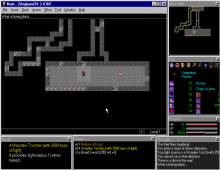OK, before I start, I'll clear some things up. I am new, I started playing ZangbandTK when I read Kieron Gillen's articly about it in the UK PCGamer Magazine in 2005. So I'm not too much of a noob, although I have only completed it once. (Level 46 Chaos Warrior, started as a Half Troll, mutated into a Half Titan at around lvl 26  and lost a few levels)
and lost a few levels)
So to ask the straight question, I have tried Vanilla, with and without tiles, and ToME and to be honest cant stand them without the easy UI that Zangband TK came with.
Tcl, and TK, A code engine of some sort that the UI for ZangbandTK is written in, is apparently easy to adapt to other variants of Angband, so the simple question is how, and how long it would take.
You've probrably gathered from how I spoke about Tcl + TK that I'm not too tech savvy, but I could never convince anyone I know to play any Variant without a basic UI to do simple things.
And as for Tim Baker, the way he wrote the Readme for it seemed like he actively encouraged the porting of the UI. Why not have a look at what it would take do it for Vanilla firstly.
 and lost a few levels)
and lost a few levels)----
So to ask the straight question, I have tried Vanilla, with and without tiles, and ToME and to be honest cant stand them without the easy UI that Zangband TK came with.
Tcl, and TK, A code engine of some sort that the UI for ZangbandTK is written in, is apparently easy to adapt to other variants of Angband, so the simple question is how, and how long it would take.
You've probrably gathered from how I spoke about Tcl + TK that I'm not too tech savvy, but I could never convince anyone I know to play any Variant without a basic UI to do simple things.
And as for Tim Baker, the way he wrote the Readme for it seemed like he actively encouraged the porting of the UI. Why not have a look at what it would take do it for Vanilla firstly.

 ). So I'll have to just settle for wishing you luck.
). So I'll have to just settle for wishing you luck.

 ... :
... :
Comment